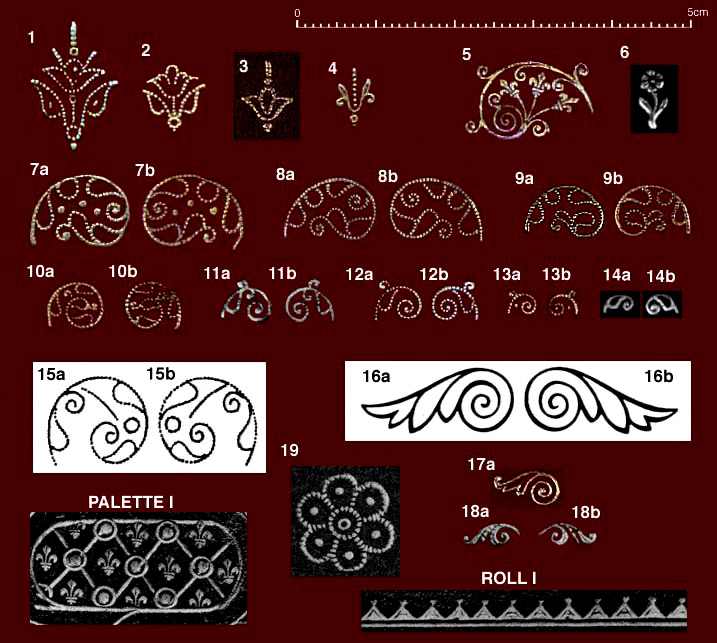

|
In Comparative Diagram 1, I have assembled a fairly complete collection of the pointillé tool imprints, extracted variously from nine reproductions of Padeloup bindings. The black on white illustrations are Esmerian imprint models. I have included those for which I did not find an actual imprint specimen. I have not included the individual strapwork imprints, which are also to be considered. Below I have reproduced part of Raphaël Esmerian's Tableau X - ANTOINE - MICHEL PADELOUP environ de 1705 à 1738 pour les décors pointillés found in his work entitled Douze Tableaux Synoptiques sur La Reliure au XVII eme Siècle, published in 1972. This catalogue is a supplement annex to the second volume of a 6 volume work entitled, Bibliotheque Raphael Esmerian published in French by Georges Blaizon, Paris 1972-1974. |
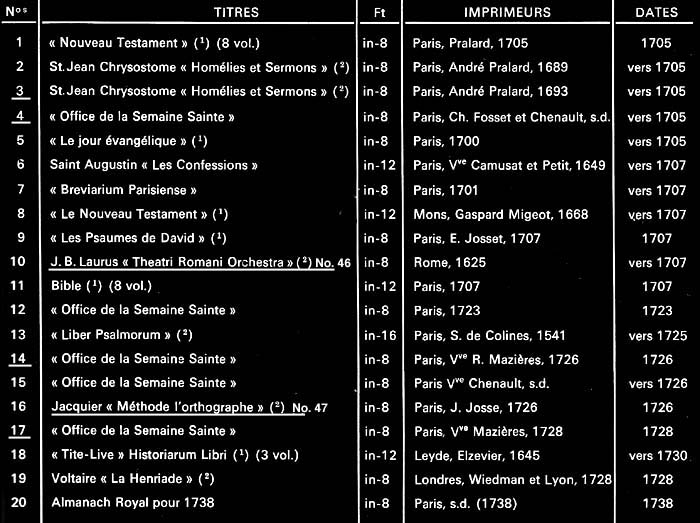
| The two underlined titles are the bindings which are shown in Esmerian's Catalogue, numbers 46 and 47. I have reproduced number 47 on the previous page and here would like to show three other examples from this list. The first is Example 4, Office de la Semaine Sainte. Published in Paris, by Ch. Fosset et Chenault s.d. (no date given). Esmerian has estimated that this binding was possibly made around 1705... if he is right this would be then, a very early example, one of the first of such bindings. |
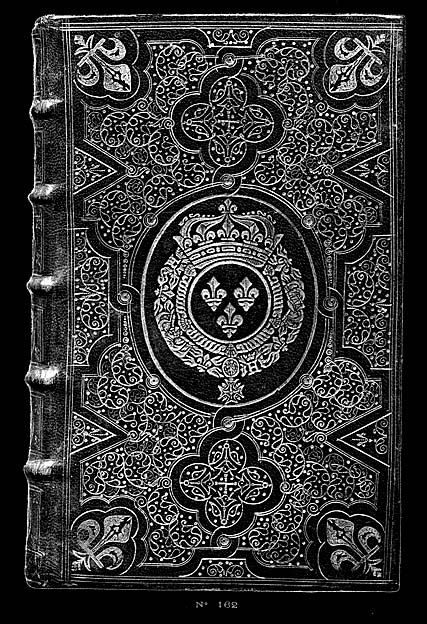
|
This binding is found in an obscure 1910 Paris publication entitled LIVRES DANS DE RICHES RELIURES by Édouard Rahir. This folio sized auction catalogue of 96 pages and 50 full sized plates is a mine of information, describing with prices 378 lots. This binding is found on Plate 27 and is numbered item 162. OFFICE DE LA SEMAINE SAINTE. Paris: Ch. Fosset s.d., Red Morocco. There is no mention of Padeloup in the description, although it is noted that the binding is in the style of Le Gascon. This book has been listed without a publication date however an approximate date is given as 1695, also noted Aux armes du roi Louis XIV. In as much as the king died in 1715, this would appear to confirm an early date for this binding. It is interesting to note also the estimated auction price listed for this item, which is given as, above 2000 francs. If you are interested in discovering what the French Franc was worth over the last century you can find it all on the web page of INSEE (The French National Institute of Statistics and Economic Studies - Institut National de la Statistique et des Études Économiques). On their chart for 1910 we see that the French Franc was worth (relative purchasing power) the equivalent of 3.45541 euros (2006) this calculates, 2000 x 3.45541 = 6910.82 euros x 1.36 = 9.398.71 US$ The large fleurs de lis in the corners are not strictly speaking pointillé, nor are the small diminishing spheres that are used as fill on both sides of the armes, although similar forms are seen in pointillé bindings. Note also the small scroll wing (pj-17a) that has been employed sparingly and without recourse to its opposing counterpart. The image quality of this 1910 reproduction is vastly superior to the average print quality of the modern age. In the enlarged images below we can compare the quality of Esmerian's 1972 example (a) to that of the Rahir printing (b). |
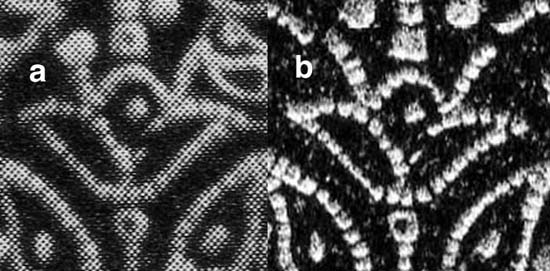
| It is fortunate then that we find yet another Padeloup binding in this indispensable Catalogue. It is fourteenth example on Esmerian's list. Item number 174 on Plate 35, OFFICE DE LA SEMAINE SAINTE. Paris: Chez la Veuve Mazières, & Jean-Baptiste Garnie, 1726. Green Morocco with gold brocade end-papers, Aux armes du roi Louis XIV and an estimated auction price of more than 2500 francs. It is stated that this binding is probably the work of Padeloup. |
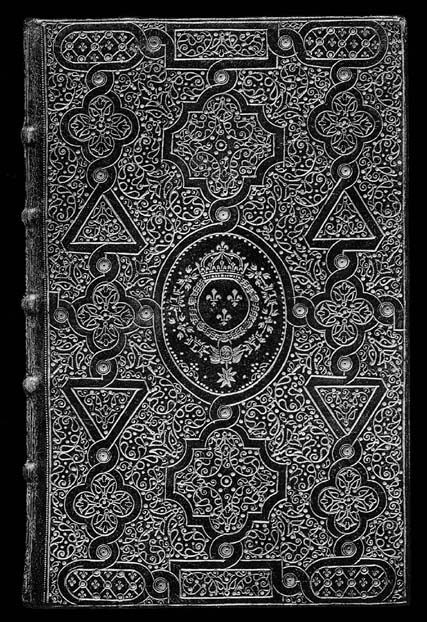
|
Also noted in the description of this book is the fact that it was actually used by the King and then in 1727, donated to the City Library of Lille. Thus we can be sure that the binding is of that period. It is difficult to imagine that more than 20 years separate these two examples. We can note the lack of one of Padeloup's most favored tools pj-2 in the 1705 binding and the presence and extensive use of the small spiral tool pj-10a and 10b in the early binding that is not found in the 1726 example. Also interesting is the total lack of any sort of decorative outer roll other than the simple filets or line of small dots. The next binding is from yet another Rahir catalogue, LA BIBLIOTHÈQUE DE FEU ÉDOUARD RAHIR - Quatrieme Partie Paris: Francisque LEFRANÇOIS, 1936. This Padeloup binding is item 1128 in the fourth volume of this six volume set. These volumes are nearly identical in layout to the 1910 catalogue. Oak Knoll Books is currently selling a complete six volume set for around $800 USD... here is their description of the set. "Six volumes. A complete set of catalogues for the Lefrançois sale of the library of E. Rahir. Blogie 313, 316, 330, 334, 338, 341. & Eacute;douard Rahir (1862-1924) was a well-known antiquarian bookseller, bibliographer, and publisher in Paris (for a time the publisher for the Société des Bibliophiles François). He had a long-standing business relationship with Quaritch in London and was the author of La Bibliothèque de l'amateur (1909 & 1924), a guide to book collecting, along with many catalogues, etc. Some items from his library were sold shortly after his death, but the majority were sold between 1930 and 1938. See Arthur Rau, "Edouard Rahir..," pp. 169-177 in the Summer 1967 (vol.16 no.2) issue of the Book Collector. This set of six catalogues lists a total of 2,091 lots of incunabula (various editions of the Ship of Fools), first editions from every period, illustrated books from over four centuries, fine and armorial bindings, etc. The 173 leaves contain 172 plates, mostly of bindings and illustrations in black-and-white, except that a few in the last three volumes which are embossed color prints. The last two volumes also contain text illustrations, generally of text and title pages or illustrations. Each volume has the Randeria bookplate on the half-title. Well preserved set" Item 1128 is shown in a full page plate slightly larger than actual size and again an excellent reproduction. |
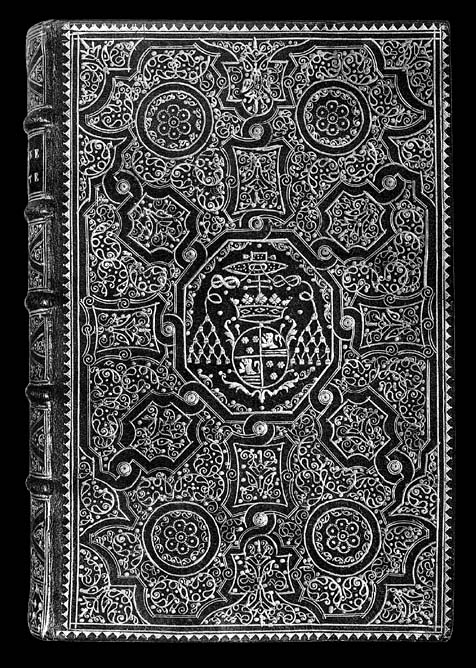
|
OFFICE DE LA SEMAINE SAINTE. Paris: Chez la Veuve Mazières, & Jean-Baptiste Garnie, 1728. Described as Red Morocco, aux armes du Cardinal Fleury, decorated in the fashion of Le Gascon. There are no prices in this set and I suspect that the item descriptions were not made by Rahir who died a decade previous to the publication of this work. The imprints from the decorative tools used to make these bindings are shown at the top of this page. They are quite limited in number, the same tools were used and virtually no others, for a span of perhaps thirty years. This last example (17) is dated 1728, however it must be noted that there are examples of this work which, although dated 1728 on the title-leaf, the "Approbation" on the verso of p. 729 is dated "1. Septembre 1739", so it may be that this binding dates to an even later period. It is interesting to note therefore the use of some new decorative tools as well as the first use an elaborate outer Roll (dog tooth, ROLL I). In the image below I have assembled eight pointillé bindings (rendered in a fanfare arrangement). I have added to them the dates assigned by Esmerian (however with some reserve). The two undated bindings are both 1701 editions of the OFFICE DE LA SEMAINE SAINTE. In as much as they are, at first sight, nearly identical, one is tempted to think that they may both be from the same period and early. In this regard we are fortunate to discover that the British Library specimen Davis533 turns out to be another very early example, it is number 3 on Esmerian's table shown above. Antoine Michel Padeloup was born on the 22nd December, 1685 and would therefore be just at the start of his apprenticeship at the turn of the century. Antoine Ruette, the son of Mace Ruette, and another son of a binder was born 5th February, 1609, and received the freedom of the Guild of St. Jean in the quality of a stationer, on the 9th July, 1637, at the age of 28. Padeloup had his own well established business by the year 1712, at the age of 26. Esmerian has however shown Padeloup's activity as starting from the year 1705 when he would have been still in his teens. |
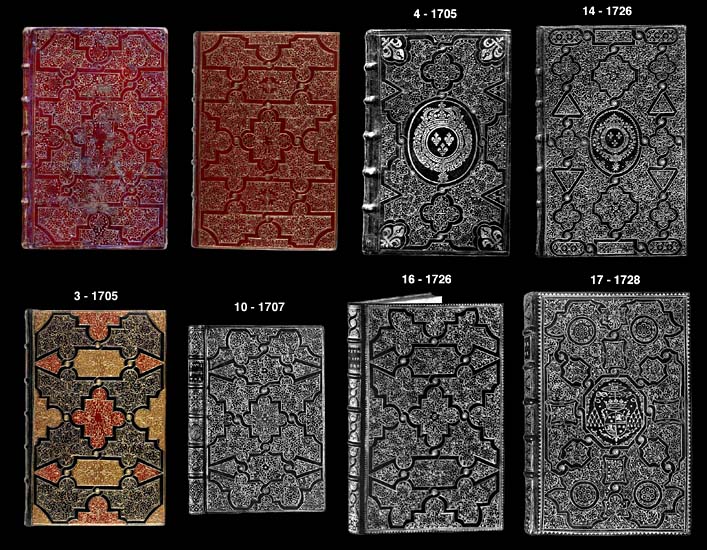
| After a brief comparative study of these bindings, I note a few possibly important differences within the early and late forms. The first undated binding at the top left , is less encumbered with fill than the later bindings, we do not see the use of pj-11a, 11b, 13a 13b, 14a or 14b to fill but rather pj-10a and 10b have been used to fill the open spaces, and these appear to have lighter impressions, thus the tooling is not uniform in appearance, as is the case with the later work. Also we can see the quite extensive use of pj-4 in this first example whereas it is absent later. Particular to this first item is the lack of filled strapwork centers. Item 4 on the list also shares some of these early characteristics, unencumbered, and not overly uniform due to the careful application of pj-10a and 10b. Note also the presence of the small scroll wing pj-17a on this volume, this wing is not found in the later bindings but appears on the second undated binding. |
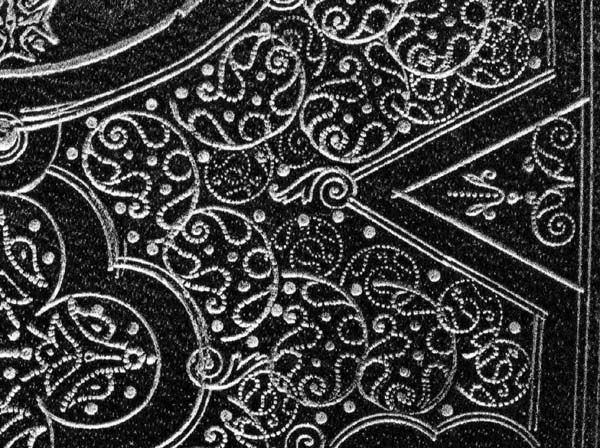
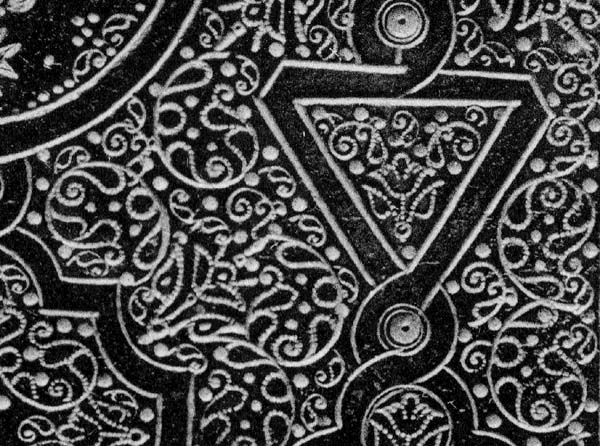
| Next Page: A Comparative study of Pointillé tools from the Atelier of Antoine Michel Padeloup. |
| Go to Digital Alchemy | return to the home page of cyclopaedia.org |